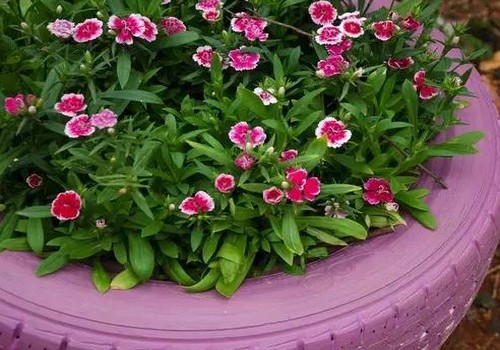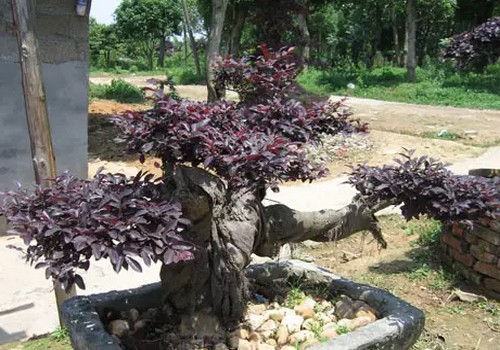Maintenance of bonsai of Carthamus tinctorius
Carthamus tinctorius has bright leaves and luxuriant leaves all the year round, especially when it blossoms. It is an ornamental tree with beautiful flowers and leaves. It is often used for color block layout or pruning into a ball, and it is also a good material for making bonsai. Today, the editor will tell you about the method of making safflower bonsai.
The production of safflower tree is basically the same as that of other miscellaneous trees. After the billet pile of Carthamus tinctorius survived completely, it should be observed and studied repeatedly according to the characteristics of the stump, conceived and modeled, and then made.
The first step in making is to determine the viewing surface. Then choose the branch to fix the bracket. When selecting branches and setting supports, branches should be selected according to the conceived tree type, and the excess branches should be cut off, but some bud space should be left for backup. To cultivate Carthamus tinctorius, it is best to use 50% loose mountain yellow mud, 30% coarse river sand, 20% pond mud or paddy field mud. (less alkaline in pond mud or field mud is better)
The transplanting time of Carthamus tinctorius is generally suitable from the beginning of February to the end of March, that is, before or after flowering, it is better to take more soil for transplantation at other times, and do not transplant in winter, because its growth stops and begins to enter the dormancy period.
In addition, according to the safflower tree transplanted at different times, the branches should be trimmed properly, less in spring and more at other times, so as to avoid evaporation of water in branches and leaves, resulting in water loss. Cover the tree stump and leaves properly when the sun is strong, and spray water on the stump and leaves according to the weather and humidity, so as to keep the trunk and leaves moist after transplanting.
1. Planting
Plant or change pots before sprouting in spring. It can be planted in the open air to survive the winter in the south of the Yangtze River. Pot planting is suitable for overwintering in the north. The land should be planted in a place with sufficient sunlight and good drainage, requiring the soil to be loose and fertile. Pot culture should choose rotten leaf soil, garden soil and river sand mixed culture soil, it is best to add appropriate amount of mature organic fertilizer or compound fertilizer. Planted with 1-2-year-old seedlings. Change the basin once every 2 years. Water after planting and keep in a half-shaded place.
2. Light and temperature
The suitable growth temperature is 20-28 ℃, and it should be cultured under full light in spring and autumn, which is beneficial to flowering and make the leaf color more beautiful. Summer should be shaded or placed in a sparse shade under trees to avoid strong direct sunlight. It should be placed in a bright place indoors, preferably with a certain amount of light every day. Move into the sunny place indoors in winter.
3. Watering and fertilization
Red rosewood is resistant to early and barren, but attention should be paid to watering during the growing period, especially in summer, and the basin soil should be kept moist, but not too wet, especially timely drainage after rain. Watering should be strictly controlled in winter, basin soil should be dry and re-irrigated, it is appropriate to wet and dry, to prevent the death of over-wet rotten roots, topdressing should be applied during the growing period, light should not be concentrated, and dilute liquid fertilizer should be applied 2-3 times a month.
4. Shaping and pruning
It should be reshaped and pruned before sprouting in spring, and the dead and overdense branches should be cut off. Pick buds at the right time during the growing period, promote the germination of new branches and blossom more, but can not be pruned in late autumn, so as to avoid cold damage to the new shoots after pruning, resulting in fallen leaves.
Ji Mu bonsai has less soil, shallow roots, poor cold resistance, easy to freeze and dry up, and even die. Therefore, winter is not suitable for overwintering outdoors, should be placed indoors, and pay attention to ventilation, room temperature to maintain more than 5 degrees; when the room temperature is more than 25 degrees, you can open the window to avoid excessive growth caused by high temperature, when the room temperature is less than 5 degrees, plastic bags can be covered (when the room temperature is higher than 5 degrees, plastic bags should be removed immediately). When the room temperature is less than 0 degrees, heating methods such as hot water should be used to protect the bonsai from overwintering.
Time: 2019-06-01 Click:
- Prev

Culture methods and matters needing attention of Carnation Flower
Carnation, also known as Luoyang flower, Chinese marsh bamboo, carnation flower, carnation orchid, ten kinds of landscape flower, Wang Yinghua, Luoyang carnation, chrysanthemum, embroidered bamboo, Changxia, sunset grass, qu wheatgrass, etc., is a perennial herb of the carnation genus of Caryophyllaceae, and is one of the traditional famous flowers in China.
- Next

Maintenance method of bonsai of Carthamus tinctorius
Carthamus tinctorius is an evergreen plant with bright red new leaves. The leaf color and flower color of different lines are different when they are mature, and the leaf size is also different. The different effects of leaf color and leaf size are mainly considered in garden application. Carthamus tinctorius has luxuriant branches, graceful posture, resistance to pruning and flat binding, and can be used in hedges.
Related
- Fuxing push coffee new agricultural production and marketing class: lack of small-scale processing plants
- Jujube rice field leisure farm deep ploughing Yilan for five years to create a space for organic food and play
- Nongyu Farm-A trial of organic papaya for brave women with advanced technology
- Four points for attention in the prevention and control of diseases and insect pests of edible fungi
- How to add nutrient solution to Edible Fungi
- Is there any good way to control edible fungus mites?
- Open Inoculation Technology of Edible Fungi
- Is there any clever way to use fertilizer for edible fungus in winter?
- What agents are used to kill the pathogens of edible fungi in the mushroom shed?
- Rapid drying of Edible Fungi

